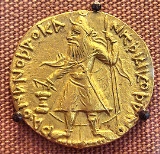
Kanishka
Encyclopedia
Kanishka ' onMouseout='HidePop("97715")' href="/topics/Bactrian_language">Bactrian language
: , Middle Chinese
: 迦腻色伽 (Jianisejia)) was an emperor of the Kushan Empire
, ruling an empire extending from Bactria
to large parts of northern India
in the 2nd century of the common era, and famous for his military, political, and spiritual achievements. His main capital was at Purushpura (Peshawar
in present day northwestern Pakistan
) with regional capitals at the location of the modern city of Taxila
in Pakistan
, Begram in Afghanistan
and Mathura in India
.
ethnicity. He used an Eastern Iranian, Indo-European language known as Bactrian
(called "αρια," i. e. "Aryan" in the Rabatak inscription
), which appears in Greek script in his inscriptions, though it is not certain what language the Kushans originally spoke; possibly some form of Tocharian
- a "centum" Indo-European language. The "Aryan" language of the inscription was a "satem" Middle Iranian language, possibly the one spoken in "Arya" or "Ariana
" (the region around modern Herat
) and was, therefore, quite possibly unrelated to the original language of the Kushans (or the Yuezhi), but adopted by them to facilitate communication with local people.
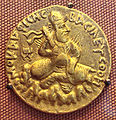 Kanishka was the successor of Vima Kadphises
Kanishka was the successor of Vima Kadphises
, as demonstrated by an impressive genealogy of the Kushan kings, known as the Rabatak inscription
. The connection of Kanishka with other Kushan rulers is described in the Rabatak inscription as Kanishka makes the list of the kings who ruled up to his time: Kujula Kadphises
as his great-grandfather, Vima Taktu as his grandfather, Vima Kadphises
as his father, and himself Kanishka:
A number of legends about Kanishka, a great patron of Buddhism, were preserved in Buddhist religious traditions. Along with the Indian kings Ashoka
and Harshavardhana, and the Indo-Greek king Menander I
(Milinda), he is considered by Buddhists to have been one of the greatest Buddhist kings.
by the Kushans and later by the Guptas in Mathura for about three centuries. Kanishka's era is now by many believed to have begun in 127 CE
on the basis of Harry Falk's ground-breaking research. The actual source, however, gives 227 CE as Year One of a Kuṣâṇa century without mentioning Kanishka's name. Since Kuṣâṇa centuries always "drop the hundreds" an incept of 127 CE was deduced by Falk on the basis of Chinese and other sources. This date and reference are disputed by some scholars.
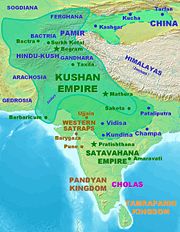 Kanishka's empire was certainly vast. It extended from southern Uzbekistan and Tajikistan, north of the Amu Darya (Oxus) in the north west to Northern India, as far as Mathura in the south east (the Rabatak inscription
Kanishka's empire was certainly vast. It extended from southern Uzbekistan and Tajikistan, north of the Amu Darya (Oxus) in the north west to Northern India, as far as Mathura in the south east (the Rabatak inscription
even claims he held Pataliputra and Sri Champa), and his territory also included Kashmir
, where there was a town Kanishkapur, named after him not far from the Baramula Pass and which still contains the base of a large stupa.
Knowledge of his hold over Central Asia is less well established. The Book of the Later Han, Hou Hanshu, states that general Ban Chao
fought battles near Khotan
with a Kushan army of 70,000 men led by an otherwise unknown Kushan viceroy named Xie (Chinese: 謝) in 90 CE. Though Ban Chao claimed to be victorious, forcing the Kushans to retreat by use of a scorched-earth policy, the region fell to Kushan forces in the early 2nd century. As a result, for a period (until the Chinese regained control c. 127 CE) the territory of the Kushans extended for a short period as far as Kashgar
, Khotan
and Yarkand, which were Chinese dependencies in the Tarim Basin
, modern Xinjiang
. Several coins of Kanishka have been found in the Tarim Basin
.
Controlling both the land (the Silk Road
) and sea trade routes between South Asia
and Rome seems to have been one of Kanishka's chief imperial goals.
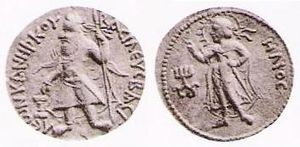 Kanishka's coins portray images of Indo-Aryan, Greek
Kanishka's coins portray images of Indo-Aryan, Greek
, Iranian
and even Sumer
o-Elamite divinities, demonstrating the religious syncretism
in his beliefs. Kanishka's coins from the beginning of his reign bear legends in Greek language and script and depict Greek divinities. Later coins bear legends in Bactrian
, the Iranian language
that the Kushans evidently spoke, and Greek divinities were replaced by corresponding Iranic ones. All of Kanishka's coins - even ones with a legend in the Bactrian language - were written in a modified Greek script that had one additional glyph (Ϸ) to represent /š/ (sh), as in the word 'Kushan' and 'Kanishka'.
On his coins, the king is typically depicted as a bearded man in a long coat and trousers gathered at the ankle, with flames emanating from his shoulders. He wears large rounded boots, and is armed with a long sword similar to a scimitar
as well as a lance. He is frequently seen to be making a sacrifice on a small altar. The lower half of a lifesize limestone relief of Kanishka similarly attired, with a stiff embroidered surplice beneath his coat and spurs attached to his boots under the light gathered folds of his trousers, survived in the Kabul Museum until it was destroyed by the Taliban.
and script: ΒΑΣΙΛΕΥΣ ΒΑΣΙΛΕΩΝ ΚΑΝΗϷΚΟΥ, basileus basileon kaneshkou "[coin] of Kanishka, king of kings."
Greek deities, with Greek names are represented on these early coins:
The inscriptions in Greek are full of spelling and syntactical errors.
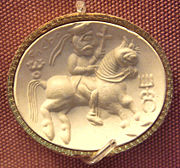 Following the transition to the Bactrian language on coins, Iranic and Indic divinities replace the Greek ones:
Following the transition to the Bactrian language on coins, Iranic and Indic divinities replace the Greek ones:
Only a few Buddhist divinities were used as well:
Additionally, ΟΗϷΟ (oesho) was long considered to represent Indic Shiva
, but recent studies indicate that oesho is Avestan Vayu
conflated with Shiva.
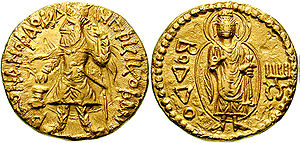
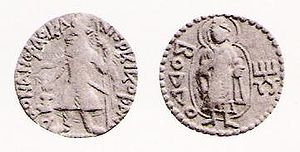 Kanishka's reputation in Buddhist tradition is based mainly on the Buddhist tradition that he convened the 4th Buddhist Council
Kanishka's reputation in Buddhist tradition is based mainly on the Buddhist tradition that he convened the 4th Buddhist Council
in Kashmir
. Images of the Buddha
based on 32 physical signs were made during his time.
He provided encouragement to both the Gandhara
school of Greco-Buddhist Art
and the Mathura school of Hindu art (An inescapable religious syncretism pervades Kushana rule). Kanishka personally seems to have embraced both Buddhism and the Persian cult of Mithra
.
His greatest contribution to Buddhist architecture was the Kanishka stupa
at Peshawar
, Pakistan. Archaeologists who rediscovered the base of it in 1908-1909 ascertained that this stupa had a diameter of 286 feet (87 metres). Reports of Chinese pilgrims such as Xuan Zang indicate that its height was 600 to 700 (Chinese) "feet" (= roughly 180–210 metres or 591–689 ft.) and was covered with jewels. Certainly this immense multi-storied building ranks among the wonders of the ancient world.
Kanishka is said to have been particularly close to the Buddhist scholar Ashvaghosha, who became his religious advisor in his later years. At the time of Kanishka's coronation and when India's first gold coin was minted, Yuz Asaf
was the spiritual advisor to the king.
. Like all coins of Kanishka, the design is rather rough and proportions tend to be imprecise; the image of the Buddha is often slightly corrupted, with oversize ears and feet spread apart in the same fashion as the Kushan king, indicating clumsy imitation of Hellenistic types.
Three types of Kanishka's Buddhist coins are known:
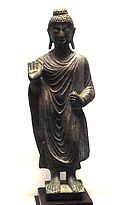 The standing Buddha in Hellenistic style, bearing the mention "Boddo" in Greek script, holding the left corner of his cloack in his hand, and forming the abhaya mudra
The standing Buddha in Hellenistic style, bearing the mention "Boddo" in Greek script, holding the left corner of his cloack in his hand, and forming the abhaya mudra
. Only six Kushan coins of the Buddha are known in gold (the sixth one is the centerpiece of an ancient piece of jewelry, consisting of a Kanishka Buddha coin decorated with a ring of heart-shaped ruby stones). All these coins were minted in gold under Kanishka I, and are in two different denominations: a dinar
of about 8 gm, roughly similar to a Roman aureus
, and a quarter dinar of about 2 gm. (about the size of an obol
).
The Buddha is represented wearing the monastic robe, the antaravasaka, the uttarasanga, and the overcoat sanghati.
The ears are extremely large and long, a symbolic exaggeration possibly rendered necessary by the small size of the coins, but otherwise visible in some later Gandharan statues of the Buddha typically dated to the 3rd-4th century CE. He has an abundant topknot covering the usnisha, often highly stylized in a curly or often globular manner, also visible on later Buddha statues of Gandhara.
In general, the representation of the Buddha on these coins is already highly symbolic, and quite distant from the more naturalistic and Hellenistic images seen in early Gandhara sculptures. On several design, a mustache is apparent. The palm of his right hand bears the Chakra
mark, and his brow bear the urna
. An aureola
, formed by one, two or three lines, surrounds him.
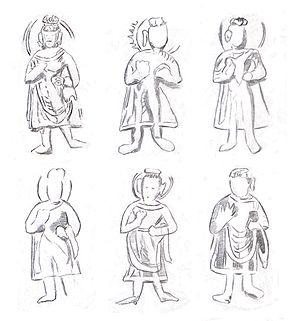 The Shakyamuni Buddha (with the legend "Sakamano Boudo", i.e. Shakamuni Buddha, another name for the historic Buddha Siddharta Gautama), standing to front, with left hand on hip and forming the abhaya mudra with the right hand. All these coins are in copper only, and usually rather worn.
The Shakyamuni Buddha (with the legend "Sakamano Boudo", i.e. Shakamuni Buddha, another name for the historic Buddha Siddharta Gautama), standing to front, with left hand on hip and forming the abhaya mudra with the right hand. All these coins are in copper only, and usually rather worn.
The gown of the Shakyamuni Buddha is quite light compared to that on the coins in the name of Buddha, clearly showing the outline of the body, in a nearly transparent way. These are probably the first two layers of monastic clothing the antaravasaka and the uttarasanga. Also, his gown is folded over the left arm (rather than being held in the left hand as above), a feature only otherwise known in the Bimaran casket
and suggestive of a scarf-like uttariya
. He has an abundant topknot covering the ushnisha
, and a simple or double halo
, sometimes radiating, surrounds his head.
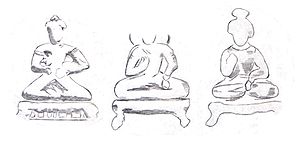 The Bodhisattva Maitreya
The Bodhisattva Maitreya
(with the legend "Metrago Boudo") cross-legged on a throne, holding a water pot, and also forming the Abhaya mudra
. These coins are only known in copper and are badly worn.
On the clearest coins, Maitreya seems to be wearing the armbands of an Indian prince, a feature often seen on the staruary of Maitreya. The throne is decorated with small columns, suggesting that the coin representation of Maitreya was directly copied from pre-existing statuary with such well-known features.
The qualification of "Buddha" for Maitreya is inaccurate, as he is instead a Bodhisattva
(he is the Buddha of the future). This may indicate a limited knowledge of Buddhist cosmology on the part of the Kushans.
The iconography of these three types is very different from that of the other deities depicted in Kanishka's coinage. Whether Kanishka's deities are all shown from the side, the Buddhas only are shown frontally, indicating that they were copied from contemporary frontal representations of the standing and seated Buddhas in statuary. Both representations of the Buddha and Shakyamuni have both shoulders covered by their monastic gown, indicating that the statues used as models were from the Gandhara
school of art, rather than Mathura.
The "Kanishka casket
" or "Kanishka reliquary", dated to the first year of Kanishka's reign in 127 CE, was discovered in a deposit chamber under Kanishka's stupa
, during the archeological excavations in 1908-1909 in Shah-ji-Dheri on the outskirts of Peshawar
. It is today at the Peshawar Museum, and a copy is in the British Museum
. It is said to have contained three bone fragments of the Buddha, which are now housed in Mandalay
, Burma.
The casket is dedicated in Kharoshthi. The inscription reads:
The text is signed by the maker, a Greek artist named Agesilas, who oversaw work at Kanishka's stupa
s (caitya), confirming the direct involvement of Greeks with Buddhist realizations at such a late date: "The servant Agisalaos, the superintendent of works at the vihara of Kanishka in the monastery of Mahasena" ("dasa agisala nava-karmi ana*kaniskasa vihara mahasenasa sangharame").
The lid of the casket shows the Buddha on a lotus pedestal, and worshipped by Brahma
and Indra
. The edge of the lid is decorated by a frieze of flying geese. The body of the casket represents a Kushan monarch, probably Kanishka in person, with the Iranian sun and moon gods on his side. On the sides are two images of a seated Buddha, worshiped by royal figures. A garland, supported by cherubs
goes around the scene in typical Hellenistic style.
The attribution of the casket to Kanishka has been recently disputed, essentially on stylistic ground (for example the ruler shown on the casket is not bearded, to the contrary of Kanishka). Instead, the casket is often attributed to Kanishka's successor Huvishka
.
Additionally, the arrival of Kanishka was reportedly foretold by the Buddha, as well as the construction of his stupa:
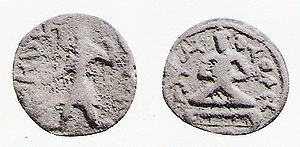 The same story is repeated in a Khotan
The same story is repeated in a Khotan
ese scroll found at Dunhuang
, which first described how Kanishka would arrive 400 years after the death of the Buddha. The account also describes how Kanishka came to raise his stupa:
Chinese pilgrims to India, such as Xuanzang
, who travelled there around 630 CE also relays the story:
probably initiated the transmission of Buddhism to China.
Buddhist monks from the region of Gandhara
played a key role in the development and the transmission of Buddhist ideas in the direction of northern Asia from the middle of the 2nd century CE. The Kushan monk, Lokaksema
(c. 178 CE), became the first translators of Mahayana
Buddhist scriptures into Chinese and established a translation bureau at the Chinese capital Loyang. Central Asian and East Asian Buddhist monks appear to have maintained strong exchanges for the following centuries.
Kanishka was probably succeeded by Huvishka
. How and when this came about is still uncertain. The fact that there were other Kushana kings called Kanishka is just another complicating factor.
series, Berserk
, the Emperor Ganishka working as Griffith's enemy in Berserk was based on King Kanishka. In the manga, he is also a profound Buddhist and adorned his empire with its respective figures and promoted it vigoriously. Like his real-life conterpart, Ganishka also decorates his palace with famous Buddhist figures, but has demonized them to suit his nature.
"Kanishka" is also one of the most popular songs by Argentine rock
band Los Brujos
, referring to the Kushan King and his wife, released in the album Fin de semana Salvaje (Wild Weekend).
Bactrian language
The Bactrian language is an extinct Eastern Iranian language which was spoken in the Central Asian region of Bactria. Linguistically, it is classified as belonging to the middle period of the East Iranian branch...
: , Middle Chinese
Middle Chinese
Middle Chinese , also called Ancient Chinese by the linguist Bernhard Karlgren, refers to the Chinese language spoken during Southern and Northern Dynasties and the Sui, Tang, and Song dynasties...
: 迦腻色伽 (Jianisejia)) was an emperor of the Kushan Empire
Kushan Empire
The Kushan Empire originally formed in the early 1st century AD under Kujula Kadphises in the territories of ancient Bactria on either side of the middle course of the Oxus in what is now northern Afghanistan, Pakistan, and southern Tajikistan and Uzbekistan.During the 1st and early 2nd centuries...
, ruling an empire extending from Bactria
Bactria
Bactria and also appears in the Zend Avesta as Bukhdi. It is the ancient name of a historical region located between south of the Amu Darya and west of the Indus River...
to large parts of northern India
India
India , officially the Republic of India , is a country in South Asia. It is the seventh-largest country by geographical area, the second-most populous country with over 1.2 billion people, and the most populous democracy in the world...
in the 2nd century of the common era, and famous for his military, political, and spiritual achievements. His main capital was at Purushpura (Peshawar
Peshawar
Peshawar is the capital of Khyber-Pakhtunkhwa and the administrative center and central economic hub for the Federally Administered Tribal Areas of Pakistan....
in present day northwestern Pakistan
Pakistan
Pakistan , officially the Islamic Republic of Pakistan is a sovereign state in South Asia. It has a coastline along the Arabian Sea and the Gulf of Oman in the south and is bordered by Afghanistan and Iran in the west, India in the east and China in the far northeast. In the north, Tajikistan...
) with regional capitals at the location of the modern city of Taxila
Taxila
Taxila is a Tehsil in the Rawalpindi District of Punjab province of Pakistan. It is an important archaeological site.Taxila is situated about northwest of Islamabad Capital Territory and Rawalpindi in Panjab; just off the Grand Trunk Road...
in Pakistan
Pakistan
Pakistan , officially the Islamic Republic of Pakistan is a sovereign state in South Asia. It has a coastline along the Arabian Sea and the Gulf of Oman in the south and is bordered by Afghanistan and Iran in the west, India in the east and China in the far northeast. In the north, Tajikistan...
, Begram in Afghanistan
Afghanistan
Afghanistan , officially the Islamic Republic of Afghanistan, is a landlocked country located in the centre of Asia, forming South Asia, Central Asia and the Middle East. With a population of about 29 million, it has an area of , making it the 42nd most populous and 41st largest nation in the world...
and Mathura in India
India
India , officially the Republic of India , is a country in South Asia. It is the seventh-largest country by geographical area, the second-most populous country with over 1.2 billion people, and the most populous democracy in the world...
.
Genealogy
Kanishka was a Kushan of probable YuezhiYuezhi
The Yuezhi, or Rouzhi , also known as the Da Yuezhi or Da Rouzhi , were an ancient Central Asian people....
ethnicity. He used an Eastern Iranian, Indo-European language known as Bactrian
Bactrian language
The Bactrian language is an extinct Eastern Iranian language which was spoken in the Central Asian region of Bactria. Linguistically, it is classified as belonging to the middle period of the East Iranian branch...
(called "αρια," i. e. "Aryan" in the Rabatak inscription
Rabatak inscription
The Rabatak inscription is an inscription written on a rock in the Bactrian language and the Greek script, which was found in 1993 at the site of Rabatak, near Surkh Kotal in Afghanistan...
), which appears in Greek script in his inscriptions, though it is not certain what language the Kushans originally spoke; possibly some form of Tocharian
Tocharian
Tocharian may refer to:* Tocharians, an ancient people who inhabited the Tarim Basin in Central Asia* Tocharian languages, two Indo-European languages spoken by those people...
- a "centum" Indo-European language. The "Aryan" language of the inscription was a "satem" Middle Iranian language, possibly the one spoken in "Arya" or "Ariana
Ariana
Ariana was a region of the eastern countries of ancient Iran, next to India.Ariana may also refer to:* Ariana In places:*Ariana Governorate, a governorate in Tunisia*Ariana, Tunisia*Lake Ariana, a lake in Sofia, Bulgaria...
" (the region around modern Herat
Herat
Herāt is the capital of Herat province in Afghanistan. It is the third largest city of Afghanistan, with a population of about 397,456 as of 2006. It is situated in the valley of the Hari River, which flows from the mountains of central Afghanistan to the Karakum Desert in Turkmenistan...
) and was, therefore, quite possibly unrelated to the original language of the Kushans (or the Yuezhi), but adopted by them to facilitate communication with local people.

Vima Kadphises
Vima Kadphises was a Kushan emperor from around 90–100 CE. As detailed by the Rabatak inscription, he was the son of Vima Takto and the father of Kanishka.-Rule:...
, as demonstrated by an impressive genealogy of the Kushan kings, known as the Rabatak inscription
Rabatak inscription
The Rabatak inscription is an inscription written on a rock in the Bactrian language and the Greek script, which was found in 1993 at the site of Rabatak, near Surkh Kotal in Afghanistan...
. The connection of Kanishka with other Kushan rulers is described in the Rabatak inscription as Kanishka makes the list of the kings who ruled up to his time: Kujula Kadphises
Kujula Kadphises
Kujula Kadphises, reigned was a Kushan prince who united the Yuezhi confederation during the 1st century CE, and became the first Kushan emperor...
as his great-grandfather, Vima Taktu as his grandfather, Vima Kadphises
Vima Kadphises
Vima Kadphises was a Kushan emperor from around 90–100 CE. As detailed by the Rabatak inscription, he was the son of Vima Takto and the father of Kanishka.-Rule:...
as his father, and himself Kanishka:
"... for King Kujula Kadphises (his) great grandfather, and for King Vima Taktu (his) grandfather, and for King Vima Kadphises (his) father, and *also for himself, King Kanishka"
A number of legends about Kanishka, a great patron of Buddhism, were preserved in Buddhist religious traditions. Along with the Indian kings Ashoka
Ashoka
Ashok Maurya or Ashoka , popularly known as Ashoka the Great, was an Indian emperor of the Maurya Dynasty who ruled almost all of the Indian subcontinent from ca. 269 BC to 232 BC. One of India's greatest emperors, Ashoka reigned over most of present-day India after a number of military conquests...
and Harshavardhana, and the Indo-Greek king Menander I
Menander I
Menander I Soter "The Saviour" was one of the rulers of the Indo-Greek Kingdom from either 165 or 155 BC to 130 BC ....
(Milinda), he is considered by Buddhists to have been one of the greatest Buddhist kings.
Kanishka's era
Kanishka's era was used as a calendar referenceCalendar era
A calendar era is the year numbering system used by a calendar. For example, the Gregorian calendar numbers its years in the Western Christian era . The instant, date, or year from which time is marked is called the epoch of the era...
by the Kushans and later by the Guptas in Mathura for about three centuries. Kanishka's era is now by many believed to have begun in 127 CE
CE
CE, Ce or ce may refer to:* Common Era , secular alternative to Anno Domini * Cerium, chemical element with symbol Ce- Titles :* Chief Executive, administrative head of some regions...
on the basis of Harry Falk's ground-breaking research. The actual source, however, gives 227 CE as Year One of a Kuṣâṇa century without mentioning Kanishka's name. Since Kuṣâṇa centuries always "drop the hundreds" an incept of 127 CE was deduced by Falk on the basis of Chinese and other sources. This date and reference are disputed by some scholars.
Conquests in South and Central Asia

Rabatak inscription
The Rabatak inscription is an inscription written on a rock in the Bactrian language and the Greek script, which was found in 1993 at the site of Rabatak, near Surkh Kotal in Afghanistan...
even claims he held Pataliputra and Sri Champa), and his territory also included Kashmir
Kashmir
Kashmir is the northwestern region of the Indian subcontinent. Until the mid-19th century, the term Kashmir geographically denoted only the valley between the Great Himalayas and the Pir Panjal mountain range...
, where there was a town Kanishkapur, named after him not far from the Baramula Pass and which still contains the base of a large stupa.
Knowledge of his hold over Central Asia is less well established. The Book of the Later Han, Hou Hanshu, states that general Ban Chao
Ban Chao
Ban Chao , courtesy name Zhongsheng , was born in Xianyang, Shaanxi, and the younger brother of the famous historian, Ban Gu who, with his father Ban Biao, and sister, Ban Zhao, wrote the famous Hanshu, or 'History of the Former Han Dynasty'....
fought battles near Khotan
Khotan
Hotan , or Hetian , also spelled Khotan, is the seat of the Hotan Prefecture in Xinjiang, China. It was previously known in Chinese as 于窴/於窴 and to 19th-century European explorers as Ilchi....
with a Kushan army of 70,000 men led by an otherwise unknown Kushan viceroy named Xie (Chinese: 謝) in 90 CE. Though Ban Chao claimed to be victorious, forcing the Kushans to retreat by use of a scorched-earth policy, the region fell to Kushan forces in the early 2nd century. As a result, for a period (until the Chinese regained control c. 127 CE) the territory of the Kushans extended for a short period as far as Kashgar
Kashgar
Kashgar or Kashi is an oasis city with approximately 350,000 residents in the western part of the Xinjiang Uyghur Autonomous Region of the People's Republic of China. Kashgar is the administrative centre of Kashgar Prefecture which has an area of 162,000 km² and a population of approximately...
, Khotan
Khotan
Hotan , or Hetian , also spelled Khotan, is the seat of the Hotan Prefecture in Xinjiang, China. It was previously known in Chinese as 于窴/於窴 and to 19th-century European explorers as Ilchi....
and Yarkand, which were Chinese dependencies in the Tarim Basin
Tarim Basin
The Tarim Basin is a large endorheic basin occupying an area of about . It is located in the Xinjiang Uyghur Autonomous Region in China's far west. Its northern boundary is the Tian Shan mountain range and its southern is the Kunlun Mountains on the northern edge of the Tibetan Plateau. The...
, modern Xinjiang
Xinjiang
Xinjiang is an autonomous region of the People's Republic of China. It is the largest Chinese administrative division and spans over 1.6 million km2...
. Several coins of Kanishka have been found in the Tarim Basin
Tarim Basin
The Tarim Basin is a large endorheic basin occupying an area of about . It is located in the Xinjiang Uyghur Autonomous Region in China's far west. Its northern boundary is the Tian Shan mountain range and its southern is the Kunlun Mountains on the northern edge of the Tibetan Plateau. The...
.
Controlling both the land (the Silk Road
Silk Road
The Silk Road or Silk Route refers to a historical network of interlinking trade routes across the Afro-Eurasian landmass that connected East, South, and Western Asia with the Mediterranean and European world, as well as parts of North and East Africa...
) and sea trade routes between South Asia
South Asia
South Asia, also known as Southern Asia, is the southern region of the Asian continent, which comprises the sub-Himalayan countries and, for some authorities , also includes the adjoining countries to the west and the east...
and Rome seems to have been one of Kanishka's chief imperial goals.
Kanishka's coinage

Greek mythology
Greek mythology is the body of myths and legends belonging to the ancient Greeks, concerning their gods and heroes, the nature of the world, and the origins and significance of their own cult and ritual practices. They were a part of religion in ancient Greece...
, Iranian
Greater Iran
Greater Iran refers to the regions that have significant Iranian cultural influence. It roughly corresponds to the territory on the Iranian plateau and its bordering plains, stretching from Iraq, the Caucasus, and Turkey in the west to the Indus River in the east...
and even Sumer
Sumer
Sumer was a civilization and historical region in southern Mesopotamia, modern Iraq during the Chalcolithic and Early Bronze Age....
o-Elamite divinities, demonstrating the religious syncretism
Syncretism
Syncretism is the combining of different beliefs, often while melding practices of various schools of thought. The term means "combining", but see below for the origin of the word...
in his beliefs. Kanishka's coins from the beginning of his reign bear legends in Greek language and script and depict Greek divinities. Later coins bear legends in Bactrian
Bactrian language
The Bactrian language is an extinct Eastern Iranian language which was spoken in the Central Asian region of Bactria. Linguistically, it is classified as belonging to the middle period of the East Iranian branch...
, the Iranian language
Iranian languages
The Iranian languages form a subfamily of the Indo-Iranian languages which in turn is a subgroup of Indo-European language family. They have been and are spoken by Iranian peoples....
that the Kushans evidently spoke, and Greek divinities were replaced by corresponding Iranic ones. All of Kanishka's coins - even ones with a legend in the Bactrian language - were written in a modified Greek script that had one additional glyph (Ϸ) to represent /š/ (sh), as in the word 'Kushan' and 'Kanishka'.
On his coins, the king is typically depicted as a bearded man in a long coat and trousers gathered at the ankle, with flames emanating from his shoulders. He wears large rounded boots, and is armed with a long sword similar to a scimitar
Scimitar
A scimitar is a backsword or sabre with a curved blade, originating in Southwest Asia .The Arabic term saif translates to "sword" in general, but is normally taken to refer to the scimitar type of curved backsword in particular.The curved sword or "scimitar" was widespread throughout the Muslim...
as well as a lance. He is frequently seen to be making a sacrifice on a small altar. The lower half of a lifesize limestone relief of Kanishka similarly attired, with a stiff embroidered surplice beneath his coat and spurs attached to his boots under the light gathered folds of his trousers, survived in the Kabul Museum until it was destroyed by the Taliban.
Hellenistic phase
A few coins at the beginning of his reign have a legend in the Greek languageGreek language
Greek is an independent branch of the Indo-European family of languages. Native to the southern Balkans, it has the longest documented history of any Indo-European language, spanning 34 centuries of written records. Its writing system has been the Greek alphabet for the majority of its history;...
and script: ΒΑΣΙΛΕΥΣ ΒΑΣΙΛΕΩΝ ΚΑΝΗϷΚΟΥ, basileus basileon kaneshkou "[coin] of Kanishka, king of kings."
Greek deities, with Greek names are represented on these early coins:
- ΗΛΙΟΣ (ēlios, HēliosHeliosHelios was the personification of the Sun in Greek mythology. Homer often calls him simply Titan or Hyperion, while Hesiod and the Homeric Hymn separate him as a son of the Titans Hyperion and Theia or Euryphaessa and brother of the goddesses Selene, the moon, and Eos, the dawn...
), ΗΦΑΗΣΤΟΣ (ēphaēstos, Hephaistos), ΣΑΛΗΝΗ (salēnē, SeleneSeleneIn Greek mythology, Selene was an archaic lunar deity and the daughter of the Titans Hyperion and Theia. In Roman mythology, the moon goddess is called Luna, Latin for "moon"....
), ΑΝΗΜΟΣ (anēmos, Anemos)
The inscriptions in Greek are full of spelling and syntactical errors.
Iranic/Indic phase

- ΑΡΔΟΧϷΟ (ardoxsho, Ashi Vanghuhi)
- ΛΡΟΟΑΣΠΟ (lrooaspo, DrvaspaDrvaspaDrvaspa is the Avestan language name of an "enigmatic" and "strangely discreet" Zoroastrian divinity, whose name literally means "with solid horses" and which she is then nominally the hypostasis of....
) - ΑΘϷΟ (adsho, AtarAtarAtar is the Zoroastrian concept of holy fire, sometimes described in abstract terms as "burning and unburning fire" or "visible and invisible fire" ....
) - ΦΑΡΡΟ (pharro, personified khwarenah)
- ΜΑΟ (mao, MahMah' or ' is the Avestan language word for both the moon and for the Zoroastrian divinity that presides over and is the hypostasis of the moon....
) - ΜΙΘΡΟ, ΜΙΙΡΟ, ΜΙΟΡΟ, ΜΙΥΡΟ (mithro, miiro, mioro, miuro, variants of MithraMithraMithra is the Zoroastrian divinity of covenant and oath. In addition to being the divinity of contracts, Mithra is also a judicial figure, an all-seeing protector of Truth, and the guardian of cattle, the harvest and of The Waters....
) - ΜΟΖΔΟΟΑΝΟ (mozdaooano, "MazdaAhura MazdaAhura Mazdā is the Avestan name for a divinity of the Old Iranian religion who was proclaimed the uncreated God by Zoroaster, the founder of Zoroastrianism...
the victorious?") - ΝΑΝΑ, ΝΑΝΑΙΑ, ΝΑΝΑϷΑΟ (variants of pan-Asiatic Nana, Sogdian nny, in a Zoroastrian context Aredvi Sura Anahita)
- ΜΑΝΑΟΒΑΓΟ (manaobago, Vohu ManahVohu ManahVohu Manah is the Avestan language term for a Zoroastrian concept, generally translated as "Good Purpose" or "Good Mind", referring to the good moral state of mind that enables an individual to accomplish his duties...
) - ΟΑΔΟ (oado, Vata)
- ΟΡΑΛΑΓΝΟ (orlagno, Verethragna)
Only a few Buddhist divinities were used as well:
- ΒΟΔΔΟ (boddo, BuddhaGautama BuddhaSiddhārtha Gautama was a spiritual teacher from the Indian subcontinent, on whose teachings Buddhism was founded. In most Buddhist traditions, he is regarded as the Supreme Buddha Siddhārtha Gautama (Sanskrit: सिद्धार्थ गौतम; Pali: Siddhattha Gotama) was a spiritual teacher from the Indian...
), - ϷΑΚΑΜΑΝΟ ΒΟΔΔΟ (shakamano boddho, Shakyamuni Buddha)
- ΜΕΤΡΑΓΟ ΒΟΔΔΟ (metrago boddo, the bodhisattava MaitreyaMaitreyaMaitreya , Metteyya , or Jampa , is foretold as a future Buddha of this world in Buddhist eschatology. In some Buddhist literature, such as the Amitabha Sutra and the Lotus Sutra, he or she is referred to as Ajita Bodhisattva.Maitreya is a bodhisattva who in the Buddhist tradition is to appear on...
)
Additionally, ΟΗϷΟ (oesho) was long considered to represent Indic Shiva
Shiva
Shiva is a major Hindu deity, and is the destroyer god or transformer among the Trimurti, the Hindu Trinity of the primary aspects of the divine. God Shiva is a yogi who has notice of everything that happens in the world and is the main aspect of life. Yet one with great power lives a life of a...
, but recent studies indicate that oesho is Avestan Vayu
Vayu-Vata
Vayu-Vata is the Avestan language name of a dual-natured Zoroastrian divinity of the wind and of the atmosphere...
conflated with Shiva.
Kanishka and Buddhism


Buddhist councils
Lists and numbering of Buddhist councils vary between and even within schools. The numbering here is normal in Western writings.-First Buddhist council Lists and numbering of Buddhist councils vary between and even within schools. The numbering here is normal in Western writings.-First Buddhist...
in Kashmir
Kashmir
Kashmir is the northwestern region of the Indian subcontinent. Until the mid-19th century, the term Kashmir geographically denoted only the valley between the Great Himalayas and the Pir Panjal mountain range...
. Images of the Buddha
Buddha
In Buddhism, buddhahood is the state of perfect enlightenment attained by a buddha .In Buddhism, the term buddha usually refers to one who has become enlightened...
based on 32 physical signs were made during his time.
He provided encouragement to both the Gandhara
Gandhara
Gandhāra , is the name of an ancient kingdom , located in northern Pakistan and eastern Afghanistan. Gandhara was located mainly in the vale of Peshawar, the Potohar plateau and on the Kabul River...
school of Greco-Buddhist Art
Greco-Buddhist art
Greco-Buddhist art is the artistic manifestation of Greco-Buddhism, a cultural syncretism between the Classical Greek culture and Buddhism, which developed over a period of close to 1000 years in Central Asia, between the conquests of Alexander the Great in the 4th century BCE, and the Islamic...
and the Mathura school of Hindu art (An inescapable religious syncretism pervades Kushana rule). Kanishka personally seems to have embraced both Buddhism and the Persian cult of Mithra
Mithra
Mithra is the Zoroastrian divinity of covenant and oath. In addition to being the divinity of contracts, Mithra is also a judicial figure, an all-seeing protector of Truth, and the guardian of cattle, the harvest and of The Waters....
.
His greatest contribution to Buddhist architecture was the Kanishka stupa
Kanishka stupa
The Kanishka stupa was a monumental stupa established by the Kushan king Kanishka during the 2nd century CE in today's Shah-ji-Dheri on the outskirts of Peshawar, Pakistan....
at Peshawar
Peshawar
Peshawar is the capital of Khyber-Pakhtunkhwa and the administrative center and central economic hub for the Federally Administered Tribal Areas of Pakistan....
, Pakistan. Archaeologists who rediscovered the base of it in 1908-1909 ascertained that this stupa had a diameter of 286 feet (87 metres). Reports of Chinese pilgrims such as Xuan Zang indicate that its height was 600 to 700 (Chinese) "feet" (= roughly 180–210 metres or 591–689 ft.) and was covered with jewels. Certainly this immense multi-storied building ranks among the wonders of the ancient world.
Kanishka is said to have been particularly close to the Buddhist scholar Ashvaghosha, who became his religious advisor in his later years. At the time of Kanishka's coronation and when India's first gold coin was minted, Yuz Asaf
Yuz Asaf
Similar to mainstream Islamic views, the Ahmadiyya Movement consider that Jesus was a mortal man, but go a step further to describe Jesus as a mortal man who died a natural death in India - as opposed to having been raised up alive to Heaven...
was the spiritual advisor to the king.
Buddhist coinage
The Buddhist coins of Kanishka are comparatively rare (well under one percent of all known coins of Kanishka). Several show Kanishka on the obverse and the Buddha standing on the reverse, in Hellenistic style. A few also show the Shakyamuni Buddha and MaitreyaMaitreya
Maitreya , Metteyya , or Jampa , is foretold as a future Buddha of this world in Buddhist eschatology. In some Buddhist literature, such as the Amitabha Sutra and the Lotus Sutra, he or she is referred to as Ajita Bodhisattva.Maitreya is a bodhisattva who in the Buddhist tradition is to appear on...
. Like all coins of Kanishka, the design is rather rough and proportions tend to be imprecise; the image of the Buddha is often slightly corrupted, with oversize ears and feet spread apart in the same fashion as the Kushan king, indicating clumsy imitation of Hellenistic types.
Three types of Kanishka's Buddhist coins are known:
Standing Buddha

Mudra
A mudrā is a symbolic or ritual gesture in Hinduism and Buddhism. While some mudrās involve the entire body, most are performed with the hands and fingers...
. Only six Kushan coins of the Buddha are known in gold (the sixth one is the centerpiece of an ancient piece of jewelry, consisting of a Kanishka Buddha coin decorated with a ring of heart-shaped ruby stones). All these coins were minted in gold under Kanishka I, and are in two different denominations: a dinar
Dinar
The dinar is the official currency of several countries.The history of the dinar dates to the gold dinar, an early Islamic coin corresponding to the Byzantine denarius auri...
of about 8 gm, roughly similar to a Roman aureus
Aureus
The aureus was a gold coin of ancient Rome valued at 25 silver denarii. The aureus was regularly issued from the 1st century BC to the beginning of the 4th century, when it was replaced by the solidus...
, and a quarter dinar of about 2 gm. (about the size of an obol
Obol
Obol may refer to:* Obolus, a type of silver coin used in Ancient Greece* Obol , a programming language* Obol Investment, a Swedish company involved in a major fraud scandal...
).
The Buddha is represented wearing the monastic robe, the antaravasaka, the uttarasanga, and the overcoat sanghati.
The ears are extremely large and long, a symbolic exaggeration possibly rendered necessary by the small size of the coins, but otherwise visible in some later Gandharan statues of the Buddha typically dated to the 3rd-4th century CE. He has an abundant topknot covering the usnisha, often highly stylized in a curly or often globular manner, also visible on later Buddha statues of Gandhara.
In general, the representation of the Buddha on these coins is already highly symbolic, and quite distant from the more naturalistic and Hellenistic images seen in early Gandhara sculptures. On several design, a mustache is apparent. The palm of his right hand bears the Chakra
Chakra
Chakra is a concept originating in Hindu texts, featured in tantric and yogic traditions of Hinduism and Buddhism. Its name derives from the Sanskrit word for "wheel" or "turning" .Chakra is a concept referring to wheel-like vortices...
mark, and his brow bear the urna
Urna
For the Mongolian singer see Urna The Urna, more correctly ūrṇā or ūrṇākośa is a spiral or circular dot placed on the forehead of Buddhist images as an auspicious mark...
. An aureola
Aureola
An aureola or aureole is the radiance of luminous cloud which, in paintings of sacred personages, surrounds the whole figure...
, formed by one, two or three lines, surrounds him.
"Shakyamuni Buddha"

The gown of the Shakyamuni Buddha is quite light compared to that on the coins in the name of Buddha, clearly showing the outline of the body, in a nearly transparent way. These are probably the first two layers of monastic clothing the antaravasaka and the uttarasanga. Also, his gown is folded over the left arm (rather than being held in the left hand as above), a feature only otherwise known in the Bimaran casket
Bimaran casket
The Bimaran casket is a small gold reliquary for Buddhist relics that was found inside the stupa no.2 at Bimaran, near Jalalabad in eastern Afghanistan....
and suggestive of a scarf-like uttariya
Uttariya
An uttariya is a piece of dress in India. It is scarf-like, and descends from the back of the neck to curl around both arms, and can be used to drape the top half of the body...
. He has an abundant topknot covering the ushnisha
Ushnisha
The ushnisha is a three dimensional oval at the top of the head of the Buddha. It symbolizes his attainment of reliance in the spiritual guide....
, and a simple or double halo
Halo (religious iconography)
A halo is a ring of light that surrounds a person in art. They have been used in the iconography of many religions to indicate holy or sacred figures, and have at various periods also been used in images of rulers or heroes...
, sometimes radiating, surrounds his head.
"Maitreya Buddha"

Maitreya
Maitreya , Metteyya , or Jampa , is foretold as a future Buddha of this world in Buddhist eschatology. In some Buddhist literature, such as the Amitabha Sutra and the Lotus Sutra, he or she is referred to as Ajita Bodhisattva.Maitreya is a bodhisattva who in the Buddhist tradition is to appear on...
(with the legend "Metrago Boudo") cross-legged on a throne, holding a water pot, and also forming the Abhaya mudra
Mudra
A mudrā is a symbolic or ritual gesture in Hinduism and Buddhism. While some mudrās involve the entire body, most are performed with the hands and fingers...
. These coins are only known in copper and are badly worn.
On the clearest coins, Maitreya seems to be wearing the armbands of an Indian prince, a feature often seen on the staruary of Maitreya. The throne is decorated with small columns, suggesting that the coin representation of Maitreya was directly copied from pre-existing statuary with such well-known features.
The qualification of "Buddha" for Maitreya is inaccurate, as he is instead a Bodhisattva
Bodhisattva
In Buddhism, a bodhisattva is either an enlightened existence or an enlightenment-being or, given the variant Sanskrit spelling satva rather than sattva, "heroic-minded one for enlightenment ." The Pali term has sometimes been translated as "wisdom-being," although in modern publications, and...
(he is the Buddha of the future). This may indicate a limited knowledge of Buddhist cosmology on the part of the Kushans.
The iconography of these three types is very different from that of the other deities depicted in Kanishka's coinage. Whether Kanishka's deities are all shown from the side, the Buddhas only are shown frontally, indicating that they were copied from contemporary frontal representations of the standing and seated Buddhas in statuary. Both representations of the Buddha and Shakyamuni have both shoulders covered by their monastic gown, indicating that the statues used as models were from the Gandhara
Gandhara
Gandhāra , is the name of an ancient kingdom , located in northern Pakistan and eastern Afghanistan. Gandhara was located mainly in the vale of Peshawar, the Potohar plateau and on the Kabul River...
school of art, rather than Mathura.
Kanishka casket
The "Kanishka casket
Kanishka casket
The Kanishka casket or "Kanishka reliquary", is a Buddhist reliquary made in gilted copper, and dated to the first year of the reign of the Kushan emperor Kanishka, in 127 CE.-History and description:...
" or "Kanishka reliquary", dated to the first year of Kanishka's reign in 127 CE, was discovered in a deposit chamber under Kanishka's stupa
Kanishka stupa
The Kanishka stupa was a monumental stupa established by the Kushan king Kanishka during the 2nd century CE in today's Shah-ji-Dheri on the outskirts of Peshawar, Pakistan....
, during the archeological excavations in 1908-1909 in Shah-ji-Dheri on the outskirts of Peshawar
Peshawar
Peshawar is the capital of Khyber-Pakhtunkhwa and the administrative center and central economic hub for the Federally Administered Tribal Areas of Pakistan....
. It is today at the Peshawar Museum, and a copy is in the British Museum
British Museum
The British Museum is a museum of human history and culture in London. Its collections, which number more than seven million objects, are amongst the largest and most comprehensive in the world and originate from all continents, illustrating and documenting the story of human culture from its...
. It is said to have contained three bone fragments of the Buddha, which are now housed in Mandalay
Mandalay
Mandalay is the second-largest city and the last royal capital of Burma. Located north of Yangon on the east bank of the Irrawaddy River, the city has a population of one million, and is the capital of Mandalay Region ....
, Burma.
The casket is dedicated in Kharoshthi. The inscription reads:
- "(*mahara)jasa kanishkasa kanishka-pure nagare aya gadha-karae deya-dharme sarva-satvana hita-suhartha bhavatu mahasenasa sagharaki dasa agisala nava-karmi ana*kanishkasa vihare mahasenasa sangharame"
The text is signed by the maker, a Greek artist named Agesilas, who oversaw work at Kanishka's stupa
Stupa
A stupa is a mound-like structure containing Buddhist relics, typically the remains of Buddha, used by Buddhists as a place of worship....
s (caitya), confirming the direct involvement of Greeks with Buddhist realizations at such a late date: "The servant Agisalaos, the superintendent of works at the vihara of Kanishka in the monastery of Mahasena" ("dasa agisala nava-karmi ana*kaniskasa vihara mahasenasa sangharame").
The lid of the casket shows the Buddha on a lotus pedestal, and worshipped by Brahma
Brahma
Brahma is the Hindu god of creation and one of the Trimurti, the others being Vishnu and Shiva. According to the Brahma Purana, he is the father of Mānu, and from Mānu all human beings are descended. In the Ramayana and the...
and Indra
Indra
' or is the King of the demi-gods or Devas and Lord of Heaven or Svargaloka in Hindu mythology. He is also the God of War, Storms, and Rainfall.Indra is one of the chief deities in the Rigveda...
. The edge of the lid is decorated by a frieze of flying geese. The body of the casket represents a Kushan monarch, probably Kanishka in person, with the Iranian sun and moon gods on his side. On the sides are two images of a seated Buddha, worshiped by royal figures. A garland, supported by cherubs
CHERUBS
CHERUBS is a Non-Profit Organization. It was founded in February, 1995 for families of children born with Congenital Diaphragmatic Hernia, a severe and often lethal birth defect. It was founded and currently led by Dawn M...
goes around the scene in typical Hellenistic style.
The attribution of the casket to Kanishka has been recently disputed, essentially on stylistic ground (for example the ruler shown on the casket is not bearded, to the contrary of Kanishka). Instead, the casket is often attributed to Kanishka's successor Huvishka
Huvishka
Huvishka was a Kushan emperor from the death of Kanishka until the succession of Vasudeva I about forty years later. His rule was a period of retrenchment and consolidation for the Empire...
.
Kanishka in Buddhist tradition
In Buddhist tradition, Kanishka is often described as a violent, faithless ruler before his conversion to Buddhism, as in the Sri-dharma-pitaka-nidana sutra:- "At this time the King of Ngan-si (Pahlava) was very stupid and of a violent nature….There was a bhikshu (monk) arhat who seeing the evil deeds done by the king wished to make him repent. So by his supernatural force he caused the king to see the torments of hell. The king was terrified and repented."
Additionally, the arrival of Kanishka was reportedly foretold by the Buddha, as well as the construction of his stupa:
- ". . . the Buddha, pointing to a small boy making a mud tope….[said] that on that spot would erect a tope by his name." Vinaya sutra

Khotan
Hotan , or Hetian , also spelled Khotan, is the seat of the Hotan Prefecture in Xinjiang, China. It was previously known in Chinese as 于窴/於窴 and to 19th-century European explorers as Ilchi....
ese scroll found at Dunhuang
Dunhuang
Dunhuang is a city in northwestern Gansu province, Western China. It was a major stop on the ancient Silk Road. It was also known at times as Shāzhōu , or 'City of Sands', a name still used today...
, which first described how Kanishka would arrive 400 years after the death of the Buddha. The account also describes how Kanishka came to raise his stupa:
- "A desire thus arose in [Kanishka to build a vast stupa]….at that time the four world-regents learnt the mind of the king. So for his sake they took the form of young boys….[and] began a stūpa of mud....the boys said to [Kanishka] ‘We are making the .’….At that time the boys changed their form....[and] said to him, ‘Great king, by you according to the Buddha’s prophecy is a to be built wholly (?) with a large stūpa and hither relics must be invited which the meritorious good beings...will bring."
Chinese pilgrims to India, such as Xuanzang
Xuanzang
Xuanzang was a famous Chinese Buddhist monk, scholar, traveler, and translator who described the interaction between China and India in the early Tang period...
, who travelled there around 630 CE also relays the story:
- " became sovereign of all Jambudvīpa (Indian subcontinent) but he did not believe in Karma, and he treated Buddhism with contumely. When he was hunting in the wild country a white hare appeared; the king gave a chase and the hare suddenly disappeared at [the site of the future stupa]….[when the construction of the stūpa was not going as planned] the king now lost patience and threw the [project] up….[but] the king became alarmed, as he [realized] he was evidently contending with supernatural powers, so he confessed his errors and made submission. These two topes are still in existence and were resorted to for cures by people afflicted with diseases."
Transmission of Buddhism to China
Kanishka's expansion into the Tarim BasinTarim Basin
The Tarim Basin is a large endorheic basin occupying an area of about . It is located in the Xinjiang Uyghur Autonomous Region in China's far west. Its northern boundary is the Tian Shan mountain range and its southern is the Kunlun Mountains on the northern edge of the Tibetan Plateau. The...
probably initiated the transmission of Buddhism to China.
Buddhist monks from the region of Gandhara
Gandhara
Gandhāra , is the name of an ancient kingdom , located in northern Pakistan and eastern Afghanistan. Gandhara was located mainly in the vale of Peshawar, the Potohar plateau and on the Kabul River...
played a key role in the development and the transmission of Buddhist ideas in the direction of northern Asia from the middle of the 2nd century CE. The Kushan monk, Lokaksema
Lokaksema
Lokakṣema , born around 147 CE, was the earliest known Buddhist monk to have translated Mahayana sutras into the Chinese language and as such was an important figure in Buddhism in China. The name Lokakṣema means 'welfare of the world' in Sanskrit.-Origins:Lokaksema was a Kushan of Yuezhi ethnicity...
(c. 178 CE), became the first translators of Mahayana
Mahayana
Mahāyāna is one of the two main existing branches of Buddhism and a term for classification of Buddhist philosophies and practice...
Buddhist scriptures into Chinese and established a translation bureau at the Chinese capital Loyang. Central Asian and East Asian Buddhist monks appear to have maintained strong exchanges for the following centuries.
Kanishka was probably succeeded by Huvishka
Huvishka
Huvishka was a Kushan emperor from the death of Kanishka until the succession of Vasudeva I about forty years later. His rule was a period of retrenchment and consolidation for the Empire...
. How and when this came about is still uncertain. The fact that there were other Kushana kings called Kanishka is just another complicating factor.
In fiction
In the mangaManga
Manga is the Japanese word for "comics" and consists of comics and print cartoons . In the West, the term "manga" has been appropriated to refer specifically to comics created in Japan, or by Japanese authors, in the Japanese language and conforming to the style developed in Japan in the late 19th...
series, Berserk
Berserk (manga)
is a manga series written and illustrated by Kentaro Miura. Set in a medieval Europe-inspired world, the story centers around the characters of Guts, an orphaned mercenary, and Griffith, the leader of a mercenary band called the...
, the Emperor Ganishka working as Griffith's enemy in Berserk was based on King Kanishka. In the manga, he is also a profound Buddhist and adorned his empire with its respective figures and promoted it vigoriously. Like his real-life conterpart, Ganishka also decorates his palace with famous Buddhist figures, but has demonized them to suit his nature.
"Kanishka" is also one of the most popular songs by Argentine rock
Argentine rock
Argentine rock , is composed or made by Argentine bands or artists, in the Spanish language. For nearly half a century it has been a major popular genre, and it is considered part of the popular music tradition of Argentina alongside Argentine Tango, and Argentine folk music.The moment when...
band Los Brujos
Los Brujos
Los Brujos was an Argentine rock band, part of the "New Argentine Rock" scene which became successful in the late 1980s and early 1990s.- Members :*Gabriel Guerrisi: guitar*Fabio "Rey" Pastrello: 2nd guitar*Alejandro Alaci: voice...
, referring to the Kushan King and his wife, released in the album Fin de semana Salvaje (Wild Weekend).
See also
- Greco-BuddhismGreco-BuddhismGreco-Buddhism, sometimes spelled Graeco-Buddhism, refers to the cultural syncretism between Hellenistic culture and Buddhism, which developed between the 4th century BCE and the 5th century CE in the area covered by the Indian sub-continent, and modern Afghanistan, Pakistan and north-western...
- Indo-Greek KingdomIndo-Greek KingdomThe Indo-Greek Kingdom or Graeco-Indian Kingdom covered various parts of the northwest regions of the Indian subcontinent during the last two centuries BC, and was ruled by more than 30 Hellenistic kings, often in conflict with each other...
- Kushan EmpireKushan EmpireThe Kushan Empire originally formed in the early 1st century AD under Kujula Kadphises in the territories of ancient Bactria on either side of the middle course of the Oxus in what is now northern Afghanistan, Pakistan, and southern Tajikistan and Uzbekistan.During the 1st and early 2nd centuries...
- Silk Road transmission of BuddhismSilk Road transmission of BuddhismThe Silk Road transmission of Buddhism to China is most commonly thought to have started in the late 2nd or the 1st century CE.The first documented translation efforts by Buddhist monks in China were in the 2nd century CE, possibly as a consequence of the expansion of the Kushan Empire into the...
External links
- A rough guide to Kushana history.
- Online Catalogue of Kanishka's Coins
- Coins of Kanishka
- Controversy regarding the beginning of the Kanishka Era.
- Kanishka Buddhist coins
- Photograph of the Kanishka casket
| Preceded by: Vima Kadphises Vima Kadphises Vima Kadphises was a Kushan emperor from around 90–100 CE. As detailed by the Rabatak inscription, he was the son of Vima Takto and the father of Kanishka.-Rule:... |
Kushan Ruler | Succeeded by: Huvishka Huvishka Huvishka was a Kushan emperor from the death of Kanishka until the succession of Vasudeva I about forty years later. His rule was a period of retrenchment and consolidation for the Empire... |

